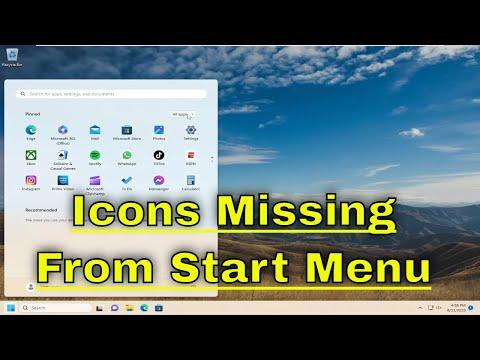I’ve been working with Windows 11 for a while now, and recently I encountered an issue that left me quite frustrated. It all started when I noticed that some icons were missing from my Start Menu. At first, it was just a minor inconvenience, but as time went on, it became a significant hindrance to my productivity. I couldn’t find my frequently used apps, and navigating through the Start Menu became a tedious task. I knew I had to find a solution to this problem as soon as possible.
The issue first came to light after I had installed a new software update. I wasn’t sure if the update had caused the problem, but I couldn’t ignore the fact that several icons had disappeared from the Start Menu. My first reaction was to restart my computer, hoping that it might resolve the issue. However, after rebooting, I found that the missing icons were still not restored. That’s when I decided to dig a bit deeper and look for a solution.
I started by checking the system files and performing a system scan. I ran the System File Checker tool (sfc /scannow) to see if there were any corrupted files that might be causing the issue. To my disappointment, the scan didn’t reveal any problems, and the missing icons persisted. I then turned to the Windows Settings to see if there was an obvious configuration issue. I checked the Start Menu settings, ensuring that the apps were set to show up on the Start Menu, but everything seemed to be in order.
Not one to give up easily, I decided to delve into the more advanced troubleshooting steps. One of the methods I found online was to use PowerShell to reset the Start Menu layout. I opened PowerShell as an administrator and ran the command to re-register the Start Menu. This step seemed promising as it was a common solution suggested in various forums and articles. I waited for the process to complete, hoping that this would bring back the missing icons. Unfortunately, after rebooting my computer again, the icons were still nowhere to be found.
Feeling a bit defeated but determined, I continued my search for a solution. I came across a suggestion to check if there were any pending Windows updates. Sometimes, issues like these are resolved with newer updates that address bugs and glitches. I navigated to the Windows Update section in the Settings and made sure my system was up-to-date. I downloaded and installed any available updates, then restarted my computer. To my dismay, the problem persisted.
Next, I decided to take a look at the user profile settings. It was possible that the issue was related to my specific user profile rather than the system as a whole. I created a new user account on my computer and logged in to see if the missing icons appeared in the Start Menu under the new profile. When I checked the Start Menu with the new account, I found that the icons were visible and everything seemed to be working fine. This indicated that the problem was isolated to my original user profile.
Realizing this, I focused on troubleshooting my user profile. One of the solutions I found was to use the built-in Windows tools to fix user profile issues. I used the “Troubleshoot settings” option, which sometimes helps in detecting and resolving problems with user profiles. After running the troubleshooter and applying any suggested fixes, I rebooted my computer and checked the Start Menu. While there were some improvements, a few icons were still missing.
At this point, I decided to use a more drastic approach: creating a new user profile and transferring my files and settings. This method would essentially start fresh with a new profile while preserving my data. I created a new user account and manually transferred my files, settings, and application preferences from the old profile to the new one. Although it was a time-consuming process, it was a surefire way to resolve the issue with the missing Start Menu icons.
Once I had moved everything over to the new profile, I logged in and checked the Start Menu. To my relief, all the icons were present and everything was functioning as expected. The new user profile resolved the issue that had been plaguing my original account. Although it took some effort and time, I was finally able to get back to my usual workflow without the distraction of missing icons.
In retrospect, while it was a frustrating experience, it taught me a lot about troubleshooting Windows 11 issues. I learned to approach problems methodically and to be patient with the troubleshooting process. Creating a new user profile was a significant step, but it was ultimately the solution that worked for me. If anyone else encounters a similar problem, I would suggest trying these steps: starting with basic troubleshooting, checking for updates, and if necessary, creating a new user profile to isolate and resolve the issue.
